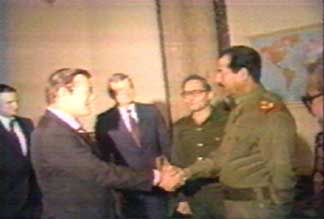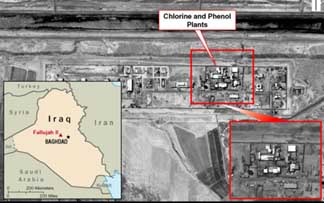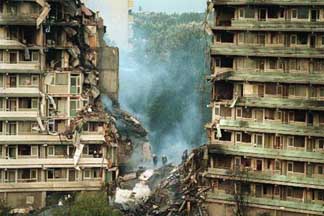
May 2003
The Great Chemical Weapons Hoax
Part 2
Go to
Part I
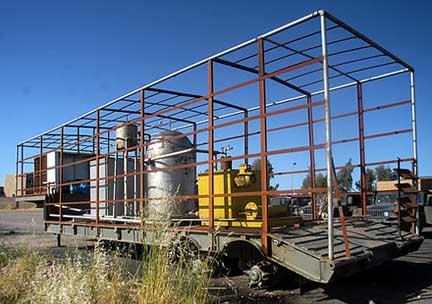
|
V. U.S. and Other
Western Imperialists
Supplied Saddam Hussein’s Chemical Weapons Long before the recent U.S./British invasion of Iraq, the charge that the Saddam Hussein regime had produced and used chemical weapons (such as mustard gas, VX and sarin), had the capability of producing biological weapons and was seeking to develop nuclear weapons has been bandied about by the imperialists to justify their unrelenting persecution of Iraq. This was the excuse for the whole charade of United Nations inspection and more than a decade of murderous UN “sanctions” which killed over a million Iraqi children. During the 1990s, the UNSCOM “inspectors” were shot through with U.S. agents, who planted surveillance devices and sent back espionage data to Washington on Iraq’s defenses. As we have emphasized, Hussein’s Iraq had every right to procure or develop any weapon needed to defend the country against the imperialist onslaught, and expulsion of the “UN”/U.S. spies was more than justified. When UN inspectors were readmitted last year, they failed to uncover any CBW (chemical and biological warfare) weapons at all and stated that everything indicated the Iraqi nuclear program had been shut down over a decade ago. Thereupon, Bush and Blair simply went ahead and ordered the attack anyway. But beyond the bottomless hypocrisy and bushels of lies from Washington and London, for years the imperialists actively supplied Iraq with chemical and biological agents, built the factories to produce CBW arms, fed Baghdad intelligence data on where to use them, and dispatched agents to the battlefields to check up on their usage. Hussein’s regime did possess and use chemical weapons against the Iranian army during the 1980-88 Iran-Iraq War. This was a bloody slaughter between two reactionary capitalist regimes in which the workers and oppressed did not have a side. The Reagan administration in Washington early on backed Hussein’s Iraq in order to block the spread of Ayatollah Khomeini’s “Islamic Revolution”; then toward the end of the nine-year carnage, the U.S. secretly aided both sides in a cynical effort to produce a battlefield stalemate. Bits and pieces of information about the United States’ deep involvement in Iraq’s use of chemical weapons occasionally seep into the bourgeois press, but these snippets are quickly buried and the dots are not connected to show the whole picture. After Baghdad’s initial successes in the war with Iran, Tehran launched “human wave” attacks with tens of thousands of Iranian soldiers overrunning Iraqi positions. The focus of these attacks was the Fao Peninsula, the spit of land south of the Shatt al-Arab (the river formed by the confluence of the Tigris and Euphrates), which is Iraq’s only access to the sea. Washington was worried that if Khomeini’s legions could storm across that narrow corridor, they could break into the vital oil-producing area of the Persian Gulf emirates and eastern Saudi Arabia (whose population is heavily Shiite). With a third the population of Iran, Iraq could not afford such heavy losses. As a last-ditch measure, Hussein began using poison gas. Last year when the Bush administration began citing Iraq’s use of gas in the war with Iran as an argument for “regime change” in Baghdad, the New York Times (18 August 2002) published an article revealing that: “A covert American program during the Reagan administration provided Iraq with critical battle planning assistance at a time when American intelligence agencies knew that Iraqi commanders would employ chemical weapons in waging the decisive battles of the Iran-Iraq war, according to senior military officers with direct knowledge of the program.” It was long known that the U.S. supplied Iraq with satellite photography of the deployment of Iranian forces. But now the Times revealed a “highly classified program in which more than 60 officers of the Defense Intelligence Agency were secretly providing detailed information on Iranian deployments, tactical planning for battles, plans for airstrikes and bomb-damage assessments for Iraq.” DIA operative Lt. Col. Rick Francona reported directly from the battlefield on Iraqi use of nerve gas. The senior DIA official at the time, Col. Walter Lang, said the U.S. was “desperate to make sure that Iraq did not lose” the war with Iran. “The use of gas on the battlefield by the Iraqis was not a matter of deep strategic concern,” he said. The Pentagon “wasn't so horrified by Iraq’s use of gas,” said another veteran of the program. “It was just another way of killing people – whether with a bullet or phosgene, it didn't make any difference.” But the Times article neglected to mention that the U.S. not only knew Iraq was using chemical weapons, but it also supplied the precursor chemicals to produce them as well as “starter strains” for biological weapons. Rumsfeld’s Handshake with Hussein Documents declassified in recent months revealed that by November 1983, Secretary of State George Shultz was receiving intelligence reports that the Iraqis were resorting to “almost daily use of CW” against the Iranians and that “Iraq has acquired a CW production capability, primarily from Western firms, including possibly a U.S. foreign subsidiary.”1 Yet simultaneously Ronald Reagan issued National Security Decision Directive 114 (26 November 1983) which declared that the U.S. would regard “any major reversal of Iraq's fortunes as a strategic defeat for the West.” It was decided to reestablish diplomatic relations with Hussein. For this purpose, none other than Donald Rumsfeld (who had been secretary of war in the previous Republican administration of Gerald Ford) was dispatched to Baghdad in December 1983 where he cordially met with the Iraqi strongman (see photo) and informed him of Washington’s new attitude. Rumsfeld was not a government official at the time but emphasized the importance of this “direct contact between an envoy of President Reagan and President Saddam Hussein.”
Donald Rumsfeld
(now U.S. secretary of war) warmly greets Saddam Hussein in December
1983. Rumsfeld was personal envoy of Ronald Reagan to arrange U.S. support
for Iraq in war with Iran. (Photo:
CNN)
Among other things, Rumsfeld pushed a project for a pipeline from Iraq to the Gulf of Aqaba in Jordan, next to Israel, to be built by Bechtel Corp, Shultz’s former company. Rumsfeld was back in Baghdad in March 1984, meeting with Foreign Minister Tariq Aziz the very day the UN cited Iraq’s use of chemical weapons against Iran; again he pushed the pipeline plan and offered Israeli support, to no avail (see Institute for Policy Studies, Crude Vision [March 2003]). In the wake of the U.S. invasion, Israel has raised the issue of a Baghdad-Haifa pipeline, and Bechtel (once headed again by Shultz) is in line to get the contract (London Guardian, 20 April). Accompanying Rumsfeld was National Security Council official Howard Teicher. In a sworn court affidavit in 1995, Teicher wrote that the United States “actively supported the Iraqi war effort by supplying the Iraqis with billions of dollars of credits, by providing military intelligence and advice to the Iraqis, and by closely monitoring third country arms sales to Iraq to make sure Iraq had the military weaponry required” (quoted in Washington Post, 30 December 2002). That weaponry included cluster bombs, supplied by a Chilean company at the CIA’s request. It was not just “third country” sales. The Post article cited a $1.5 million order for pesticide chemicals from Dow Chemical, notorious for its production of napalm and Agent Orange for use in Vietnam. Approval was granted even though the export control officer noted that these chemicals would cause “death by asphyxiation.” That was not all that U.S. companies supplied. In an article titled “Anthrax for Export” (Progressive Magazine, April 1998), William Blum noted that “private American suppliers, licensed by the U.S. Department of Commerce, exported a witch’s brew of biological and chemical materials to Iraq,” including bacillus anthracis, clostridium botulinum and dozens of other pathogenic biological agents. This was detailed in a staff report for U.S. senator Don Riegle of the Senate Committee on Banking on “U.S. Chemical and Biological Warfare-Related Dual Use Exports to Iraq” (7 October 1994). The report notes that these deadly organisms “were not attenuated or weakened and were capable of reproduction,” and it adds: “It was later learned that these microorganisms exported by the United States were identical to those the United Nations inspectors found and removed from the Iraqi biological warfare program.” So UN inspectors “found” exactly what the U.S. firms sent to Iraq with the permission of the U.S. government – some discovery! Yet to this day the New York Times (14 April), while admitting that the means for making Iraq’s chemical weapons “came primarily from Western companies years ago,” pretends that: “The data reveals that firms in Germany and France outstripped all others in selling the most important thing – specialized chemical-industry equipment that is particularly useful for producing poison gas.” So it’s supposedly the perfidious French and Germans at it again! But wait. Explaining an accompanying map, which lists no American firms, the writers state, “The countries of origin are compiled based on the exporter, not the manufacturer, because it was the exporter who decided to sell a sensitive item to Iraq.” So if the U.S. manufacturer exports it to Germany or France for re-export in order to evade U.S. export controls, as regularly occurred, or sends it via its own German or French subsidiary, for the Times this counts as a French or German export! This piece, from the Washington-based Wisconsin Project on non-proliferation, is the U.S. war propaganda machine at work again. Fallujah 2: Britain’s Dirty Secret In fact, not only did Monsanto and Dow Chemical and dozens of U.S. laboratories supply Iraq with materials for chemical and biological weapons, with full approval of the Department of Commerce, but the very industrial plants cited today by U.S. and British leaders as supposed proof that Iraq has “weapons of mass destruction” were built for Hussein with full knowledge that they could be used to produce CW arms. A case in point is the Fallujah 2 plant 80 km. outside of Baghdad. Spy satellite photos of the plant identifying it as a chemical weapons site were published by the CIA, and Colin Powell featured it in arguing for an invasion of Iraq at the UN Security Council in February. The same plant figured prominently in last September’s dossier by Britain’s Joint Intelligence Committee, which claimed that the plant (rebuilt after the 1991 Gulf War) was “formerly associated with the chemical warfare programme.” What Blair didn’t say, but the London Guardian (6 March) later revealed, was that the Fallujah plant was exported to Iraq by a British subsidiary of a German company, after approval by Margaret Thatcher’s cabinet over internal objections that it could be used to produce CW arms.
Fallujah 2
chlorine plant. CIA published satellite photos of plant, identifying it as
chemical weapons site. UN inspection showed plant was inactive. (Photo: National Security Archive)
The Guardian exposé, titled “Britain’s Dirty Secret” shows that “British ministers knew at the time that the £14 million plant, called Falluja 2, was likely to be used for mustard and nerve gas production.” A Foreign Officer minister objected to the sale, but he was overruled by the trade minister in line with London’s policy of backing Hussein against Iran. The plant was built in 1985 by Uhde Ltd., a British subsidiary of Uhde, GmbH of Dortmund, which in turn was a subsidiary of the German chemical giant Hoechst. Not only did the British government approve the deal, it granted an export credit guarantee and eventually paid Uhde (now owned by Thyssen-Krupp) £300,000 when Iraqi payments were interrupted by the Gulf War. If Fallujah did produce chemical weapons before 1990, the responsibility is to be laid squarely on the doorstep of the British prime minister’s residence at No. 10 Downing Street. Whether this was ever a poison gas plant is another question.
Repeated UN inspections since last November reported that the plant was
inactive. The plant formerly produced chlorine, which can be used to produce
epichlorohydrin (a precursor to mustard) or phosphorus trichloride (a precursor
of nerve gas). Yet chlorine is the key chemical for water purification,
which is what Baghdad said it was used for. The Foreign Office argument in
1985 was that Iraq already had enough chlorine plants. But after the Gulf
War, Iraq’s entire chlorine production capacity was destroyed, and the U.S.
deliberately targeted Iraqi waterworks. The resulting contaminated water
supply produced massive sickness and disease. The Fallujah plant’s chlorine
was desperately needed for water purification, and there is not a shred
of evidence it was used for anything else in the last decade. Yet under
UN sanctions, the U.S. refused to allow any import of materials for chlorine
production. The Iraqi people paid the price with hundreds of thousands of
deaths. 1These documents can be found on
the Internet in the briefing book “Shaking Hands with Saddam Hussein:
The U.S. Tilts toward Iraq, 1980-1984” (http://www.gwu.edu/~nsarchiv/NSAEBB/NSAEBB82/index.htm)
on the site of the National Security Archive, a private group which has
obtained large quantities of documentation of the American government’s
skullduggery around the world. |
|
The key evidence to back up the charge that Saddam Hussein “gassed his own people,” which in turn was the battle cry for the U.S./British attack on Iraq, is the death of several thousand Iraqi Kurds in the town of Halabja in March 1988. (A Kurdish researcher gave the estimate of 3,200 dead.) Various human rights groups who make a profession of pushing for imperialist military intervention, from Yugoslavia to Iraq, have cited this to portray the Iraqi strongman as a Hitler-like figure, calling up the images of the gassing of Jews in the Nazi death camps. In his weekly radio talk of March 15, on the eve of the invasion, U.S. president George Bush declared: “Fifteen years ago, Saddam Hussein's regime ordered a chemical weapons attack on a village in Iraq called Halabja. With that single order, the regime killed thousands of Iraq’s Kurdish citizens. Whole families died while trying to flee clouds of nerve and mustard agents descending from the sky. Many who managed to survive still suffer from cancer, blindness, respiratory diseases, miscarriages, and severe birth defects among their children. The chemical attack on Halabja – just one of 40 targeted at Iraq’s own people – provided a glimpse of the crimes Saddam Hussein is willing to commit, and the kind of threat he now presents to the entire world. He is among history’s cruelest dictators, and he is arming himself with the world's most terrible weapons.”In fact, it is George Bush and his “regime” (including both parties of U.S. imperialism) who are armed with a vast arsenal of the most terrible weapons and constitute a mortal threat to the peoples of the world. But given how this incident is waved as a bloody flag, we must ask what happened at Halabja. Was this genocide? What is certain is that a large number of Kurdish civilians were killed by chemical weapons in Halabja. Photos show horrendous scenes of bodies all over town. What is not at all certain is whose chemical weapons killed them. This has been long disputed, not only by the Iraqi government. For the attack on Halabja took place in the middle of a bitter battle between the Iranian and Iraqi armies, with Kurdish forces participating on the Iranian side. Moreover, during the fighting over this town on the Iran-Iraq border, both sides used gas, as they were regularly doing at that time in battles from north to south. These facts are never mentioned by the U.S. and British governments, which makes their accounts suspect from the outset. Furthermore, Washington’s current story conflicts with what Washington’s spokesmen said at the time, when the U.S. (and others) said that it appeared that Iranian gas had killed the Kurdish civilians. 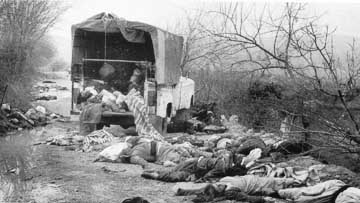
Kurdish civilians killed in poison gas attack at Halabja, March 1988. What is not clear is whether Iraqi or Iranian gas killed them. (Photo: Kurdistan Regional Government) “Most of the casualties in Halabjah were reportedly caused by cyangen chloride. This agent has never been used by Iraq, but Iran has shown interest in it. Mustard gas casualties in the town were probably caused by Iraqi weapons because Iran has never been noted using that agent.”A joint Dutch-Belgian team of Doctors Without Borders (Artsen zonder Grenzen, an affiliate of the French-based Médecins sans Frontières) which examined bodies a week later found that while there was evidence of mustard gas, many of the victims showed symptoms indicating a cyanide-based compound. A later UN investigation condemned the use of poison gas against civilians at Halabja but did not determine which country was responsible. A number of sources confirm that most of the deaths were due to a cyanide agent, and also that Iraq did not use HCN at any point while Iran did. “Iraq relied more on persistent agents because it was on the defensive, whereas Iran had developed rapidly dissipating agents of the chlorine and cyanide types in order not to hamper its advances” (Zanders). Even reports accusing Iraq note that shortly after the attack, “Iranian soldiers flitted through the darkened streets, dressed in protective clothing, their faces concealed by gas masks,” and that “The Iranians were ready for the influx of refugees. Iranian helicopters arrived…in the late afternoon and military doctors administered atropine injections to the survivors” (from the July 1993 Human Rights Watch report, Genocide in Iraq). Moreover, the Iranians immediately began bringing in journalists to take pictures of the Kurdish victims, who were left on the ground for days for filming. 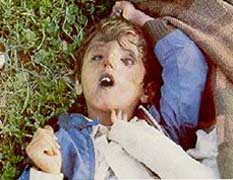
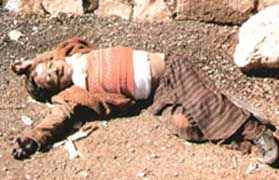
Children killed by poison gas at Halabja. Discoloration of many bodies indicates use of chlorine gas, which Iraq did not have at the time but Iranian army did. (Photos: Kurdistan Regional Government) “The truth is, all we know for certain is that Kurds were bombarded with poison gas that day at Halabja. We cannot say with any certainty that Iraqi chemical weapons killed the Kurds. This is not the only distortion in the Halabja story. “I am in a position to know because, as the Central Intelligence Agency's senior political analyst on Iraq during the Iran-Iraq war, and as a professor at the Army War College from 1988 to 2000, I was privy to much of the classified material that flowed through Washington having to do with the Persian Gulf. In addition, I headed a 1991 Army investigation into how the Iraqis would fight a war against the United States; the classified version of the report went into great detail on the Halabja affair.”Pelletiere noted that treatments of the issue by those pushing for war against Iraq, such as an influential article by Jeffrey Goldberg (“The Great Terror,” New Yorker, 25 March 2002), don’t even mention the reports that Iranian gas may have killed the Kurds. Pelletiere’s letter ends, “Until Washington gives us proof of Saddam Hussein’s supposed atrocities, why are we picking on Iraq on human rights grounds, particularly when there are so many other repressive regimes Washington supports?” Certainly, this former CIA and Army analyst is “in a position to know.” Most U.S. wars in the last century have used an incident supposedly demonstrating the enemy’s perfidy in order to stampede the population into imperialist slaughter. The Spanish-American war which launched the U.S. colonial empire was fought on the battle cry of “Remember the Maine!” even though there is no evidence that the Spanish or Cuban rebels blew up the USS Maine in Havana harbor in 1898, and plenty to suggest either that the explosion was an accident or that the Americans may have blown it up themselves. The U.S. entered World War II after the Japanese “sneak attack” on Pearl Harbor, which top officials in Washington were amply informed was coming, but ignored in the expectation that an attack on “U.S. soil” would overcome antiwar sentiment. (They clearly underestimated the toll the attack would take on the U.S. Pacific Fleet.) In the Vietnam War, the Gulf of Tonkin incident, a supposed attack by North Vietnamese torpedo boats in August 1964 which never took place, was used to justify the bombing of Hanoi. And now, since the U.S. has been unable to come up with any evidence that Iraq has had chemical or biological weapons for the last decade, Halabja is being used as the latest casus belli for Bush’s invasion of Iraq. With the present publicly available information, it is not possible to say definitively what took place at Halabja. But even if the Saddam Hussein regime were responsible for indiscriminately gassing and killing Kurdish civilians there, it is the height of cynicism for U.S. rulers to use this a “justification” for an American war on Iraq. Not only is Washington speaking with a forked tongue, having said at the time that Iran was responsible for the gas attack on the Kurds. As we have shown, the U.S. had been supplying Iraq with the chemicals and plants to produce the poison gas it was using in the Iran-Iraq war, and indeed, it was precisely in early 1988 that a Defense Intelligence Agency colonel was touring battlefields with Iraqi officers. It is a fact that Saddam Hussein’s forces brutally repressed the Kurds in northern Iraq and the Shiites in the south. It is also a fact that the Iranian government, both under the shah and under the mullahs, brutally suppressed the Kurds in Iran, killing thousands. Where are the U.S. complaints about that? And it is an indisputable fact that Turkey has for decades suppressed the Kurdish population of Anatolia with unparalleled ferocity, killing over 40,000 and wiping thousands of villages from the face of the earth. Yet Turkey is a strategic ally, and the U.S. justifies and actively participates in the repression of Turkish Kurds (as do the “peace-loving” German imperialists). Hussein’s Ba’ath nationalist regime in Baghdad and Khomeini’s Islamic regime in Tehran were together responsible for the carnage of the Iran-Iraq war in which over a million people were killed. But so was the U.S., which armed both sides of this reactionary war. (Donald Rumsfeld’s handshake with Saddam in 1984 was followed by Oliver North’s present of a Bible, a cake and planeloads of Hawk anti-aircraft missiles to Iran in 1986.) As the Internationalist Group noted in our 20 March statement on the war on Iraq: “The many crimes of Hussein are the crimes of the imperialists who backed him. And it will take revolution by the Iraqi workers, Sunni and Shi’ite alike, mobilized independently of and against the imperialist aggressors, to put an end to the likes of Hussein and his former patrons.” |
|
VII. The U.S. Arsenal of
Chemical and Bioweapons
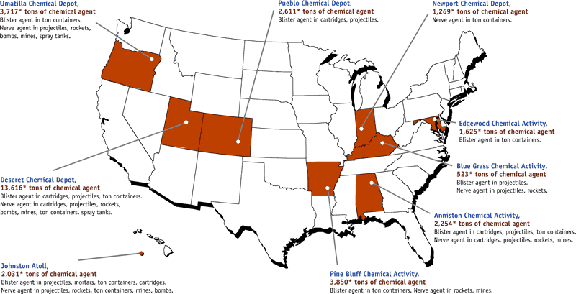
Map shows major U.S. chemical weapons stockpiles. (Map by Federation of American Scientists) ● As of July 1997, the United States had stockpiled 31,500 tons of mustard, VX and GB (sarin) weapons, in addition to untold quantities of “non-stockpile” chemical weapons to be found on military installations in 39 out of the 50 states. Bush argued that “Saddam Hussein had upwards of 30,000 munitions capable of delivering chemical agents.” Yet the U.S. not only has munitions “capable of”delivering CW agents: ● As of July 1997, the United States had stockpiled more than 3 million (3,095,000) already-assembled chemical weapons in the U.S. ● Some 88,000 of these U.S. poison gas weapons are stored at the Pine Bluff, Arkansas chemical weapons center alone, near a largely black community, which has been a center of the U.S. CW weapons program since World War II. Even larger amounts are stored in other sites. ● 660,000 of these chemical weapons are stored in Anniston, Alabama, which is complaining that the mortar shells and rockets are leaking, and plans to burn them are a threat to nearby black neighborhoods. ● 780,000 chemical munitions are stored in Pueblo, Colorado, with its heavily Latino population. ● 1,100,000 chemical munitions (mainly GB) are stored in at the Tooele ordnance depot in Utah. In the fall of 2000, the U.S. Department of Energy “conducted tests over Salt Lake City using a gas meant to mimic a toxic cloud” (Los Angeles Times, 8 October 2001). But any toxic cloud over the Desert Kingdom (Utah) isn’t going to come from Iraq (or North Korea) but from the huge arsenal of sarin 25 miles from downtown. In the State of the Union speech, Bush argued that “Saddam Hussein had materials sufficient to produce more than 38,000 liters of botulinum toxin.” This is the main ingredient of the popular cosmetic surgery product Botox, which the U.S. produces vast quantities of every year. And, Bush argued, in 1999 “Saddam Hussein had biological weapons sufficient to produce over 25,000 liters of anthrax,” whatever that is supposed to mean. ● Yet U.S. Army scientists have been producing weapons-grade anthrax for years at the Dugway Proving Ground in Utah and at Fort Detrick in Maryland, even though the U.S. biological warfare program supposedly shut down in 1969. Moreover, this weaponized anthrax is “virtually identical to the powdery spores used in the mail attacks that have killed five people,” as the Baltimore Sun (12 December 2001) revealed at the time of the post-September 11 mail attacks. Meanwhile, the U.S. invaders in Iraq have so far come up with: Zero (0) sarin, mustard or VX chemical weapons; Zero (0) chemical munitions; Zero (0) botulinum toxin; and Zero (0) anthrax. As for so-called “precursor chemicals” (like chlorine), you could find a hundred times more in any 10 square mile area of northern New Jersey than the pittance they have come up with in Iraq. Which is not to say that they won’t eventually “find” (that is, plant) some CW material in order to justify their invasion. |
|
VII. The Bush Gang and Chemical Weapons The cynicism of Washington’s claims that it had to invade Iraq because of the Saddam Hussein regime’s hypothetical possession of chemical and biological weapons is underscored by the fact that, not only does the U.S. have huge stocks of such weapons, possibly the largest in the world, but the Bush regime has consistently opposed international conventions outlawing possession and use of CW weapons! In November 2001, U.S. representatives at a United Nations conference on the 1972 Biological Warfare Convention mounted a publicity operation to “name and shame” countries it claims were violating the treaty. Tops on the list were Iraq, North Korea and “probably Iran.” As the Iraqi delegate rightly noted, this stunt meant the U.S. was “envisaging Iraq as a target, a second target for an attack” after Afghanistan. Yet only months beforehand, in July 2001, the chief U.S. negotiator walked out of a session preparing a protocol aimed at strengthening monitoring of the BWC. Washington’s rejection of the protocol led to its demise. Many people wondered why. Among the reasons given by the Bush administration was that it opposed international inspection or even disclosure of American bioweapons facilities. The U.S. had long claimed it had terminated all work on biological arms in 1969, but a couple of months after its dramatic walkout, the New York Times (4 September 2001) revealed that Washington was developing new germ weapons: the Defense Department built a small germ weapons plant at the Nevada nuclear test site; the Central Intelligence Agency developed a cluster bomb designed to disperse bomblets that would release germs in a mist; a Department of Energy program is testing the aerosol dispersal of “simulants,” while its budget indicates plans to test “actual agents” (i.e., weaponized germs); and the Defense Intelligence Agency has been seeking to produce a more powerful strain of anthrax. The DOD, DOE, CIA and DIA programs are only the ones which have been leaked to the public. Beyond these specific projects, a number of scientists are now asking if “perhaps the United States rejected the protocol not just because it is conducting secret, offensively oriented ‘biodefense’ programs, but because it is committed to continuing and expanding them” (see “Back to Bioweapons?” Bulletin of the Atomic Scientists, January-February 2003). As for chemical weapons, U.S. war propaganda made much of the fact that Iraq didn’t sign the Chemical Weapons Convention, negotiated in 1993. What Washington’s disinformation mills didn’t mention is that the present inhabitants of the White House fought tooth and nail against U.S. ratification of the CWC. At Senate hearings in April 1997, the speakers against the treaty banning chemical weapons included former (and present) secretary of war Donald Rumsfeld; former secretary of war (and current vice president) Dick Cheney; former deputy assistant (presently assistant) secretary of war Douglas Feith; and former assistant secretary of war (who was until recently chairman and is still a member of the Defense Policy Board) Richard Perle. Another prominent opponent of the CWC was the former deputy under (presently under) secretary of war Dov Zakheim. This is precisely the gang of left-over hard-line Cold Warriors that has been pushing the U.S. war drive against Iraq, using the pretext that Saddam Hussein has, or had, or was trying to get, or had the materials to make, chemical weapons but was resisting international inspections of Iraqi facilities. Yet the main argument these war hawks made against the CWC is that it would open the U.S. to the kind of inspections to which they were subjecting Iraq! Israel's Chemical and Biological Warfare Program But there was another reason behind their objections to the Chemical Weapons Convention. In Rumsfeld’s Senate testimony he complained that the CWC “could conceivably disarm democratic, friendly, non aggressive nations, that either do not have chemical weapons, or if they have them would be most unlikely to use them against us” (Senate Foreign Relations Committee Hearings, 8 April 1997). And who might that be? The answer is immediately obvious: Israel. These are all prominent members of the Zionist lobby in Washington: Feith was a campaign advisor for Israeli right-wing premier Benyamin Netanyahu; together with Perle was a co-author of the June 1996 policy paper “A Clean Break: A New Strategy for Securing the Realm” calling for Israeli domination of the Near East; Perle, Rumsfeld, Feith, Zakheim along with Elliot Abrams, Paul Wolfowitz and other current Bush administration officials jointly wrote a letter to then president Bill Clinton in February 1998 demanding that his bombing of Baghdad (Operation Desert Fox) be turned into full-scale war for “regime change” in Iraq. Note also that while Israel signed the CWC, it has not ratified it. Why? As the Federation of American Scientists tersely noted, “Israel has nuclear and chemical weapons, and an offensive BW program.” A big one.
Israel cargo
jet crashed into Amsterdam housing project in October 1992, killing 43.
Illnesses among residents and rescue workers sparked inquiry and revelation
that El Al plane was carrying chemicals for deadly sarin nerve gas. (Photo: AP)
We have written of the Israeli nuclear program, which includes hundreds of nuclear weapons and delivery systems capable of striking every country in the Near East (and the former Soviet Union), and whose scope has been known since it was revealed by the courageous Israeli nuclear technician Mordechai Vanunu in 1986 (see “Free Mordechai Vanunu!” The Internationalist No. 14, September-October 2002). A corner of the cloak of secrecy covering the Zionist regime’s chemical and biological weapons program was lifted as a result of the 1992 crash of an El Al cargo jet after takeoff from Schipol Airport in the Netherlands when it hit an Amsterdam apartment block, killing 47. Men in white suits were seen sifting through the debris. Up to 2,000 residents and firemen later reported health complaints. Six years later, the Dutch paper NRC Handelsblad (30 September 1998) published a cargo manifest showing that the flight was carrying 800 kilograms of depleted uranium and the chemicals to make 190 liters of the nerve gas sarin. It was destined for the Israeli Institute of Biological Research at Nes Ziona. A biologist formerly associated with the IIBR told the London Times (4 October 1998): “There is hardly a single known or unknown form of chemical or biological weapon...which is not manufactured at the institute.” Given how the Israeli authorities reacted to Vanunu’s revelations
(kidnapping him and imprisoning incommunicado for the last 17 years),
it’s clear that the Zionist state and its defenders will go to great lengths
to prevent any inspection of its chemical and bioweapons programs. |
International Socialist Revolution!
Much of the above has appeared in various publications. Liberals and reformists have written about how the British colonialists used poison gas in Iraq, how the U.S. and British air forces firebombed Dresden, how the United States napalmed Vietnam and poisoned the country with Agent Orange, how Washington knew of Hussein’s use of chemical weapons against Iran, and even how the U.S. supplied Baghdad with chemicals and biological agents for its CW and BW programs in the 1980s. In each case, what they seek to show is the hypocrisy of the U.S. rulers as the latter go to war against yet another of their former Third World allies and puppet dictators. But they do not show the broader picture. There is plenty of hypocrisy coming out of the Bush and Blair propaganda machines, to be sure, but what this all shows, taken together, is that there are forces whose possession of weapons of mass destruction is a threat to humanity, who have used them against their own and many other peoples, and who are fully prepared to plunge the world into radioactive barbarism. It is the imperialists, with U.S. imperialism in the forefront – not Saddam Hussein’s Iraq – who constitute this clear and present danger to humanity.
It is not enough to expose the imperialists’ boundless hypocrisy, it is necessary to fight to defeat them. As Lenin and Trotsky stood with the Rif Berbers against French and Spanish colonialism in the 1920s, as the Fourth International defended Ethiopia against Italian imperialism in the ’30s, as revolutionaries defended North Korea against the U.S. Army wearing UN shoulder patches in the Korean War of the ’50s and fought for the victory of the Vietnamese Revolution in the 1960s and ’70s, as Trotskyists hailed the Red Army in Afghanistan and supported its struggles against “holy warriors” (among them one Osama bin Laden) dispatched by the CIA against the Soviet Union in the ’80s, as we stood with Iraq against the imperialists in the first Gulf War, defended Yugoslavia against the U.S./NATO war in 1995 (Bosnia and Croatia) and again in ’99 (Kosovo), and defended Afghanistan in 2001, so it is necessary in this latest imperialist dirty war to defend Iraq and mobilize the international working class to defeat the U.S. colonialist invasion and occupation. So too it will be necessary to defend the North Korean, Vietnamese, Cuban and Chinese deformed workers state against the next imperialist war that is already being prepared in the bowels of the Pentagon.
This history makes clear that the fight cannot be simply against a particular war, for the string of wars is unbroken. It cannot be in support of other imperialists, such as the French and Germans, who joined with the U.S. in its previous wars and who are today policing Bosnia, Kosovo, Macedonia and Afghanistan in the wake of American-led imperialist attacks. It cannot be in political alliance with “Third World” nationalists, who at best stood on the sidelines (where they were not secretly cooperating with Washington): they are only angling for a deal with imperialism. It cannot be in alliance with any capitalist political force, for this history makes abundantly clear that the cause of these wars is capitalist imperialism, and they will continue to occur until the imperialist system is overthrown. As we expose the hypocritical rhetoric spouted by the warmongers to grease their machinery of death, we must direct the struggle to mobilize the social force that has the power to defeat them: the international working class.
Reflecting on the horrors of the first imperialist world war, the German communist Rosa Luxemburg declared that the alternatives facing mankind were socialism or barbarism. Today, 85 years later, the war on Iraq constitutes a giant step toward a new inter-imperialist world war, only this time by forces armed with vast arsenals of nuclear, chemical and biological weapons of mass destruction. Rather than spreading treacherous pacifist illusions, which mislead and demoralize those who would wage a serious fight against the imperialist slaughter, the League for the Fourth International has called forthrightly for class war against the imperialist war. We also seek, within the limits of our very modest forces, to carry out and spark actions aimed at mobilizing the tremendous power of the working class. We fight to build revolutionary workers parties around the globe in the struggle to smash the imperialist system through workers insurrections at the head of all the oppressed. This was the banner under which Lenin and Trotsky led 1917 October Revolution in Russia and began the construction of the first workers state in history. International socialist revolution is the only road to peace. n
To contact the Internationalist Group and the League for the Fourth International, send e-mail to: internationalistgroup@msn.com
